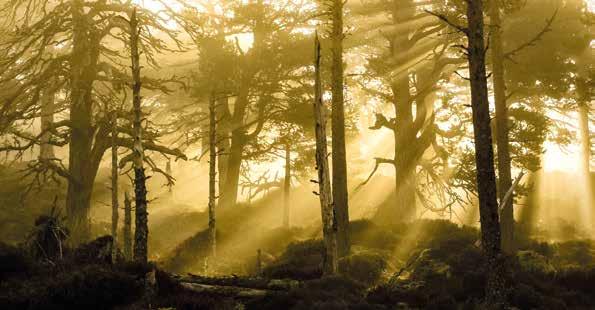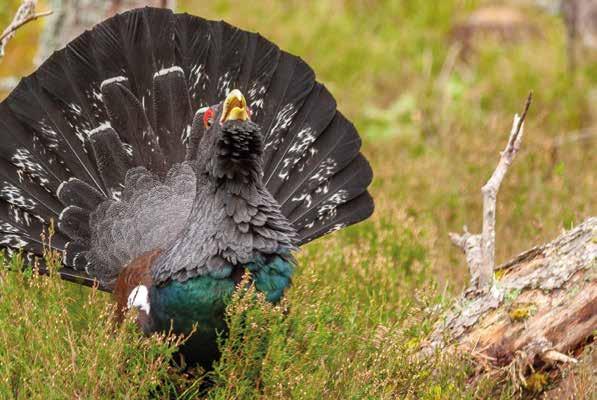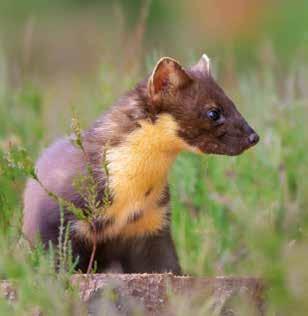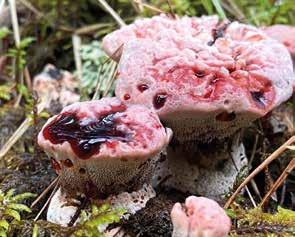
8 minute read
Scotland’s landscape Wildlife and forestry
By Emily Alsford, Recreation Ranger for Forestry and Land Scotland
Glenmore forest was once part of the
Advertisement
Great Caledonian Forest, with the timber (Caledonian pine) being used for ship building and even for sewer pipes in London. Before railways came in, logs were floated down the river to the mouth of the Spey towards Fochabers. There were numerous saw mills set up in the forest and today you can still see some of their founds left behind.
Am Monadh Ruadh
Asilence and stillness like no other can hang in these hills, while at other times raging blizzards will tear through the freezing air. Ages have gone by since two continents collided, spewing magma which slowly cooled into granite rock. This hardwearing red-pink granite was a domineering area of sharp, jagged peaks. Ice, wind and water have left their mark on these ancient mountains over 400 million years, rounding their tops--although this plateau is no less dignified as a result, rather more so. Ice age, tropical warmth, rivers and more have led to an extremely diverse ecology in the Cairngorm Plateau, making it a real Jewel in Scotland’s crown.
An area rich in history and culture: wandering in this place alone on an evening in winter, it can seem at times as if the old stories in folklore may not be so dead as we privileged modern folk so condescend to think.
In this vast plateau, blanketed in deep snow, a skier slides through a pine forest with her collie, enjoying the feeling of freedom and space that comes when rounding a corner: the open view appears. So much choice: left or right, straight ahead, what a playground. After some distance, cutting her own tracks through deep powder with head bowed, a blizzard begins, with strong winds gusting. The thought of that small flask of sweet coffee under a gnarled Scots Pine tempts her. Shuffling through the snow and heather to the tree, she sits there with the dog, enjoying the total freedom. Nothing lonely about it, but a feeling of total comfort and belonging in this place, under this tree, at this time. Light fades and the temperature drops, often surprisingly quickly, as the sun slips behind the hills. The decision to

It’s on this slide home, in the lowering light, with the wind hurling gritty ice, that the hills can let their façade down, bringing on a feeling that you are not, as human, the greatest thing in this landscape. A humility creeps in and a sense of something far greater than self. The living landscape around, its infinitely intricate networks of life, systems and processes, stretching out under, around, and above us--some so complex and as yet poorly understood. Weather and rock, forest and water bodies begin to add up to feel almost as living entities themselves. It is very easy in this instance, with the light fading and the wind moaning, to begin to understand the origins of our fairy folklore, and the reasons behind its emergence.
A stand-alone, old leaning fence post at a distance seems briefly to move in her peripheral vision--through the stinging snow, her eyes could be deceiving her. When looking at the post directly, it bears a resemblance to an elderly walker, stooping on their way down the hill to a stone ruin with disproportionately large non-native trees outside. Caught out and frozen in their tracks, perhaps? The thought of shapeshifting beings, was not so ridiculous to those having to walk their way home alone on a night like this, years ago.
There were stories of beings said to be protectors of this landscape. They were feared and respected, genuinely believed by many to be real. The Fairy King who was believed to call the woods to the east shore of Loch Morlich his home, would have been well respected. Fairies could certainly give extraordinary gifts, but were more than able to take away the things they gifted, or those whom you loved. The fearsome giant in highland dress with a bloody hand, who roamed the woods to west shore of the loch, would challenge to a duel those who took more than they needed from the forest. Those discovered to be greedily taking more firewood than necessary, for example, would see a very unpleasant outcome, it was said.
Capercaillie (By Colin Leslie): A magnificent bird on the verge of extinction in Scotland, its call is one of the strangest in the bird world; Described as a resonant rattling, which turns into the sound of a drawing cork, then the glug of wine being poured, and finally, a knife grinding noise.
NATURE
Over the last few years major conservation work has been taking place, by the removal of non-native trees, such as sitka and Norway spruce. This is to encourage the natural re-generation of the Scots pine and other native hardwoods. Some areas have been planted with oak, birch and aspen.

Our population and wealth have increased vastly since the days when folk so believed these warnings told by the fireside. Life has changed in leaps since then. Though perhaps there was really some moral message in the tales: take more than you need and you will lose out on more than you realise. This beautiful landscape is so old and so special, home to some of our rarest and most vulnerable wildlife. Now, more than ever, it is important that we work together to protect and enhance the landscape for the wildlife which makes its home there and which visitors so enjoy seeing and knowing lives there.
Environmental protection on a landscape-scale
Efforts to protect this landscape and its wildlife can seem rather out of reach for many of us. In addition, the very fact that much of this special wildlife is so expert at evading us, means it is all too easy to become complacent: forgetting it is there and does need us to adjust our behaviours in order to support it. We can all “do our bit” though, no gesture is too small. The efforts made by individuals to take their litter home, for example, really do make the difference to a place. Enjoying a day out in the hills, with the mind-set of respecting them and the nature that they are home to, cultures the right behaviours. If thousands of people visit a place of beauty and all take one step towards ensuring they leave no trace, this certainly makes a difference. But, if we all aim to do more, do our best, encourage others around us and children to do their best, then the positive impact on our countryside could be even greater.
We all have responsibilities when exercising our access rights in the Scottish countryside. The Scottish Outdoor Access Code (SOAC) details these rights and responsibilities, which fall under the three rules below:
• respecting the interests of other people
• caring for the environment
• taking responsibility for your own actions
During the COVID-19 pandemic, being considerate of others has been so very important and highlighted daily all over the news and social media. Gestures of kindness extend beyond giving a colleague a call or checking in on a friend who might be struggling. We are currently feeling or likely have felt the challenges this time has brought on. We can show consideration for others and respect for our beautiful countryside by leaving no trace of a visit there, leaving it beautiful and clean for the next visitor, for the wildlife which makes its home there, for the communities who live in the area. This can involve taking all our
Red Squirrel (By Colin Leslie): An iconic mammal of the Cairngorms, they are smaller than Grey Squirrels and make messy dreys (nests) high up in trees. Look out for chewed pine cones beneath trees: a good indicator that a Red Squirrel was there earlier making a meal of pine seeds.
Pine Marten (By Colin Leslie): Preferring native and oldgrowth forests, these agile, tree-climbing mustelids will also make a home in pine plantations. In the past they were heavily persecuted, but UK numbers are now stabilising. They are likely highly beneficial to UK ecosystems.


litter away with us, toileting responsibly, clearing up after our dogs, and importantly at Glenmore, having no fires or coal barbeques in wooded areas.
Glenmore Forest Park has experienced increasing visitor numbers over recent years, with unprecedented numbers after the first lockdown period. This summer season it will be very important that our visitors are aware of the key rules of SOAC and follow the guidance given by rangers and other staff in the Cairngorms. All efforts made by visitors to do this are always appreciated, as is an awareness of the impact that even one person’s activity can have. There will be more staff than ever patrolling the area and available to assist visitors. Rest assured that staff will do their very best to assist and keep the forest park a clean, pleasant and safe place to visit. We can all play a role in maintaining the Cairngorms, including beautiful areas like Glenmore Forest Park, and ensuring they continue to be a special place for generations to come.

Oblong-leaved Sundew (By Pete Short) & Grass of Parnassus (By Emily Alsford): Sundews are carnivorous plants and Grass of Parnassus is a beautiful white flower. Both plants are found in some marshy areas around the west of Loch
Morlich, so do be careful to cycle and walk on the tracks and paths, not desire lines and threaded paths, as this can damage their marshy habitat. Woolly Tooth Fungus, Blood Tooth Fungus (By Emily Alsford): Woolly Tooth is a critically endangered fungus with spines underneath instead of gills. It has been found in the SSSI (Site of Special Scientific Interest) to the west shores of Loch Morlich, a very popular area for visitors. Blood Tooth is another rare fungus with spines underneath, growing in Glenmore Forest Park. Named Blood Tooth as it exudes red liquid which resemble droplets of blood!


For more information on rights of responsible access in Scotland see www.outdooraccess-scotland.scot For activities to do at home for all ages see www.forestryandland.gov.scot/learn And to plan a visit to one of our forests www.forestryandland.gov.scot/visit










